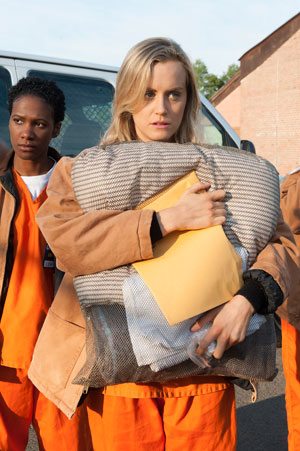Orange is the New Black’s Taylor Schilling on her career-defining role as a woman doing time


When Piper Kerman confessed to her friends that she—a self-described “nice blonde lady” living in the bourgie side of Brooklyn—was going to jail for laundering money for a drug kingpin, they laughed at her. It took weeks to convince some of her inner circle that her conviction wasn’t a joke.
Nobody was laughing when she was handcuffed and sent to a federal correctional facility in Danbury, Conn., for 15 months in February 2004, more than a decade after she committed the crime—a time she calls her wild, experimental 20s. Kerman’s past almost destroyed her relationships with her unknowing fiancé, friends and family.
“It’s an indelible experience,” Kerman says from her office in New York, where she now works at a communications firm. “It makes such an impression on you that you can’t leave it behind. I think about it all the time.”
While serving her sentence, Kerman was meticulous about taking notes, chronicling her fish-out-of-water-and-into-frying-pan story for what would become her best-selling 2010 memoir, Orange Is the New Black: My Year in a Women’s Prison. The book’s newfound popularity has inspired a Netflix series by Weeds creator Jenji Kohan.
“The series is an adaptation, so there are some wild departures from the actual events recounted in my book,” admits Kerman, who was brought into the project to consult. “Some of the scenes are just as exciting or funny or horrifying for me to watch as they might be for other viewers.” An episode directed by Jodie Foster had Kerman recalling the sometimes startling, sometimes humorous moments she encountered while navigating the social protocols at her prison’s mess hall.
Actress Taylor Schilling was chosen to play Piper Chapman, a Kerman-esque character, for the series. Rather than imitate the woman she got to know behind the cameras, the 28-year-old Bostonian—best known for roles in Argo and The Lucky One—decided to find common ground between them.
“Being in [jail] is akin to learning the rules of a country club,” Schilling says during the shooting of Orange Is the New Black’s last episode in New York City. “This isn’t a show like Oz. It’s a different beast altogether.” Instead of portraying a violent, stereotypical view of prison life, the scripts emphasize the dramas surrounding class and status issues in prison.

The show, Schilling says, homes in on the relationships between inmates from various backgrounds and economic situations. “The most interesting thing about them all is how they deal with the personal unpeeling that happens when they are confined,” she adds. “In prison there is an area called the ghetto, where the black inmates serve time. The white women are in a place called the suburbs, and the Latinas are in a [section] called Spanish Harlem.” One of Piper’s saving graces was the secret, makeshift beauty parlour where many inmates got pampered and socialized. “Prison is a harsh environment—it’s dehumanizing and not feminine at all,” says Kerman. “The one way inmates kept their femininity was by taking care of themselves—their hair, their skin, their uniforms. I put on blush and sunscreen to feel closer to who I was before I got to jail. It helped us from going insane.”
Schilling’s character could easily have slid into melodrama, but after chatting with Kerman, the actress made a conscious decision to move away from exploitive or histrionic clichés. “Piper could be your best friend. Her life was on a pretty relatable trajectory,” she says. “Thankfully, none of the stuff that I did when I had just gotten out of college was to that level, but it certainly could have been. It’s almost scary to think: Is there anything in your past that you did that could come back 10 years later?”
Aside from the empathy, Kerman’s small-screen story is also told via clothes. Jennifer Rogien, who put together much-talked-about looks for Girls (Hannah Horvath’s hotpants, Marni Michaels’s pencil skirts) and The Good Wife (Alicia Florrick’s pantsuits), felt that in order to create Piper’s world, she needed to go through old JC Penney catalogues from the late ’90s and early 2000s.
“Some would think wardrobe wouldn’t be of the utmost importance in a production like this, but thank God for flashbacks,” Rogien says after finishing a fitting with Schilling for the show. “We wanted to use as much colour as possible, since the world of prison is so de-saturated. We wanted jewellery to be a big presence, since you don’t see that in prison.” It was sourced largely from Century 21, Zara, J.Crew and consignment shops.
“Much emphasis was placed on how each inmate wore their prison uniform as well,” Rogien adds. “There are so many regulations that I had to have a cheat sheet with all the rules on it. We also had to put our heads together and really differentiate characters by how they styled themselves in prison. In that way, it was so much more of a challenge than Girls is. We also found out crochet is a common [pastime] for inmates. We had to hire a crochet consultant because Etsy wasn’t fast enough. An expert from New Jersey does all of our one-of-a-kind pieces.”
Schilling also says that the wardrobe brings forth revelations about her character’s journey. “What I thought Piper was in the beginning has changed because of what she wore in the flashbacks,” she says. “She gets pushed into places that she didn’t even think existed within her.” n
“Being in [jail] is akin to learning the rules of a country club…. This isn’t a show like oz.”







